In My Travels - Everyone Turns
- Posted on
- By Claudine Burke
- 0

This must be the most efficient system of turning patients I have ever seen.
I have been blessed with the opportunity to experience nursing practice in different facilities and countries. I have seen and experienced new practices and some old practices "done differently". Today, I would like to share my experience with an old practice done differently.
In most facilities, it is common (and evidence-based) practice to initiate Q2H (every 2 hours) turns or repositioning of patients who are unable to shift their body weight independently. We understand the skin protective benefits of the practice and the importance and its importance cannot be overemphasized. Despite our best efforts though, we sometimes miss Q2H turns a few times each shift. Okay, you don't have to admit it out loud. We know that our shifts get busy, we forget, or have to prioritize more urgent tasks or patient needs and postpone repositioning. Of course, we are not robots (at least most of us aren't) so if the patient's current state (such as hemodynamic instability, behavioural issues that may escalate with physical touch exist, etc.) dictate otherwise, we should opt for patient (and staff) safety.
What if I told you that I served at a facility where all the patients whose Braden scores (and other factors) indicated Q2H turns were always turned on time, without fail, every single shift? Before you start thinking that I am living in dream land, I must tell you that it is true.
The facility has a system in place to ensure that this very important task is not missed (intentionally or unintentionally). I know you are holding your breath at this point, so I will just tell you how it's done. After several aggregating factors are considered (including the healthcare team members' assessments), the charting system flags patients who should be placed on a Q2H turning schedule. That's step one.
Secondly, an order is generated for Q2H turns. After that a Q2H turn sign is placed on the patient's door by the Unit Secretary. Now, your next question is "so how does any of that GUARANTEE that the patients will actually be turned on time?" Yes, I can read your mind. Keep reading...
Each clinical team member is assigned a turn time slot. The turn team is made up of 2 different team members every 2 hours. These team members work together to turn each patient with a Q2H turn sign on their doors. Also, if a bedside nurse's current assessment indicates that her patient may benefit from scheduled repositioning, he/she may add the patient verbally until the system generated messages take effect. This system reduces the likelihood of skin breakdown or pressure injuries while spreading the responsibility of Q2H turns over the entire clinical team. It also allows other team members to "lay eyes" on the patients at different times throughout each shift. Nurses are usually exempt from turning at peak medication times and at shift change.
After experiencing this efficient system, I couldn't help but wonder how beneficial it would be if the turn team would also perform basic patient and room safety checks too. The team could ensure that each patient's:
-
- Call bell is still within reach
- Personal belongings are still within reach (such as cell phone, iPads, water, snacks, TV remote [if different from the call bell])
- IVs are not infusing in the bed linen (due to disconnection from the hub or dislodgment)
- IV sites are still healthy (no infiltration/extravasation, phlebitis etc.)
- Suction is turned on
- Periarea is still dry and clean
- Comfort is addressed (if awake)
- Oxygen delivery systems are working as intended (nasal cannulas are in the nares etc.)
- Bed alarm is on
- Restraints are still on securely (but not too tight
The turn team will communicate the identified needs or changes made to the bedside nurse.
If you agree with us on the efficiency of this system, let us know. If you have questions and would like to implement this system in your facility, please contact me at [email protected].
Together, let's make healthcare better.

Comments
Be the first to comment...